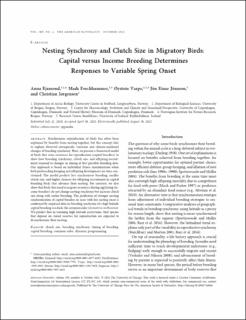Nesting synchrony and clutch size in migratory birds: Capital versus income breeding determines responses to variable spring onset
Journal article, Peer reviewed
Published version

Åpne
Permanent lenke
https://hdl.handle.net/11250/2990728Utgivelsesdato
2021Metadata
Vis full innførselSamlinger
- Department of Biological Sciences [2235]
- Registrations from Cristin [9791]
Sammendrag
Synchronous reproduction of birds has often been explained by benefits from nesting together, but this concept fails to explain observed intraspecific variation and climate-mediated changes of breeding synchrony. Here, we present a theoretical model of birds that store resources for reproduction (capital breeders) to show how breeding synchrony, clutch size, and offspring recruitment respond to changes in timing of first possible breeding date. Our approach is based on individual fitness maximization when both prebreeding foraging and offspring development are time constrained. The model predicts less synchronous breeding, smaller clutch size, and higher chances for offspring recruitment in capital breeding birds that advance their nesting. For contrast, we also show that birds that need to acquire resources during egg laying (income breeders) do not change nesting synchrony but increase clutch size along with earlier breeding. The prediction of stronger nesting synchronization of capital breeders in years with late nesting onset is confirmed by empirical data on breeding synchrony of a high-latitude capital breeding sea duck, the common eider (Somateria mollissima). We predict that in warming high-latitude ecosystems, bird species that depend on stored reserves for reproduction are expected to desynchronize their nesting.
